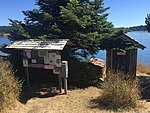Shaw Island

Shaw Island is the smallest of the four San Juan Islands served by the Washington State Ferries. The island has a land area of 19.952 square kilometers (7.704 square miles) and a small year-round population of 188 (2020 census). During the summer time, weekends swell with other residents and the occasional tourist. The island is within the historical territory of the Lummi Nation. The United States obtained Shaw Island and the rest of the San Juan archipelago by treaty in 1855, but Lummi retained certain cultural and resource rights, including fishing. The Wilkes Expedition, in 1841, named the island after John Shaw, a United States Naval Officer. According to Bill Tsilixw James, hereditary chief of the Lummi Nation, the Lummi know the island as Sq'emenen. A San Juan Island resident proposed to the state Board of Geographic Names in 2015 that Squaw Bay be renamed Sq'emenen Bay; that proposal generated a compromise proposal from the Shaw Island Historical Society to rename the bay Reef Net Bay, in recognition of the reef net fishing historically and currently done there. The name "Reef Net Bay" was adopted.
Excerpt from the Wikipedia article Shaw Island (License: CC BY-SA 3.0, Authors, Images).Shaw Island
Blind Bay Road,
Geographical coordinates (GPS) Address Nearby Places Show on map
Geographical coordinates (GPS)
| Latitude | Longitude |
|---|---|
| N 48.5732 ° | E -122.9573 ° |
Address
Blind Bay Road 2340
98286
Washington, United States
Open on Google Maps





